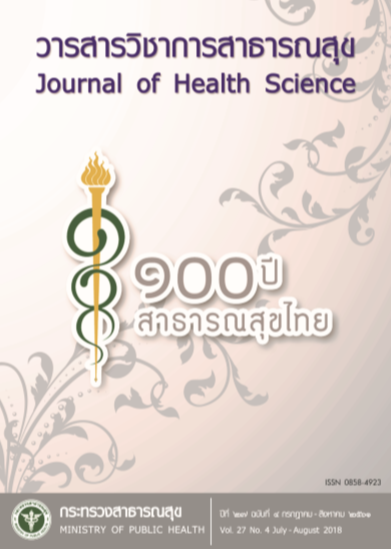Evaluation of Iodine Deficiency Prevention and Control Program in Kalasin Province Using CIPPI Model
Keywords:
evaluation project, iodine deficiency, CIPPI modelAbstract
This research aimed to strengthen cooperation mechanisms of integration of partners at all levels to mobilize the district health management for the prevention and control of iodine deficiency; and to assess the overall success of the project by using CIPPI model. It was conducted during October 2015 to July 2016. Samples included the population in the study sites, local leaders responsible for mobilizing iodine programs, and the target populations of iodine deficiency program, namely the pregnant women and infants born in all hospitals in the province. Data were collected from the observations, in-depth interviews, focus group discussions listening to presentations, random quality survey of iodized salt and sending specimens for laboratory assessment of iodine level; and were analyzed both quantitative and qualitative statistics. It was found that: (1) regarding the Social Context, people of all age groups had a problem to get access to iodized salt, particularly the women before pregnancy, delayed antenatal care, and had limited level of awareness on the long-term effects of iodine defficiency on child development; (2) as for the Input, there was a clear policy of program integration into practice in all areas with sufficient funding and supplies; (3) regarding the Process, the province had set clear goals to put together the implementation measures including district iodine integration, monitoring the manufacturing and distribution of iodized salt quality, setting iodine issue to become a development agenda at all levels, creating ownership of the local administrative organizations on sub-district iodine deficiency management for every age group, and focusing on the long-term health achievement in the future generation; (4) as for the Product, many indicators were found to be promising, such as the percentage of newborns with the level of thyroid stimulating hormone over 11.2 mU/L was 8.4% (against the criteria of ‹3.0% ), the median urinary iodine in pregnant women was 141.8 4g/L (criteria >150.0 ug/L), the coverage of intake for iodized tablets in pregnant women was 88.8% (criteria 100.0%), the antenatal care attendance before 12 weeks was 60.1% (criteria 60.0%), the coverage of iodized salt consumption in households was 91.9% (criteria 90.0%), the quality of iodized salt in the household was 71.9.% (criteria 90.0%), the quality iodized salt at the manufacture sites was 100.0% (criteria 100.0%), the districts passing the qualification as the iodine district were at 100.0% (criteria 100.0%; (5) regarding the Impact, the local authorities had increased their role in managing their own health; and the key target populations received high coverage of care and increased access to quality iodine. The authors recommended to put more efforts to ensure that people of all age groups have access to sufficient level of iodine, to encourage early prenatal care, to promote child development from the womb, and to feed information back to the local and the family care teams in order to promote quality of surveillance monitoring of iodine supplementation and individual child development.
Downloads
Downloads
Published
How to Cite
Issue
Section
License
Copyright (c) 2018 Journal of Health Science- วารสารวิชาการสาธารณสุข

This work is licensed under a Creative Commons Attribution-NonCommercial-NoDerivatives 4.0 International License.







